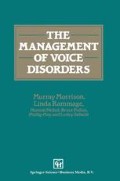Abstract
It is apparent that voice disorders frequently labelled ‘functional’ are associated with laryngeal muscle misuse. This use of the word ‘functional’ is, however, intrinsically ambiguous, and so we propose an alternative term based on descriptive features of dysfunction: muscle misuse voice disorders. Patterns of misuse are traditionally classified by the glottic and supraglottic shapes or postures that are noted on indirect laryngoscopy. A typical example is use of the term dysphonia plica ventricularis, when hyperadduction of the false vocal cords is observed in the dysphonic patient. But there are several additional observable forms of misuse.
Access this chapter
Tax calculation will be finalised at checkout
Purchases are for personal use only
Preview
Unable to display preview. Download preview PDF.
References
Arnold, G.E. (1980) Disorders of laryngeal function, in Otolaryngology (eds M.M. Paparella and D.A. Shumrick) W. Saunders, Philadelphia, PA., 3, 2470–88.
Aronson, A.E. (1985) Clinical Voice Disorders: An Interdisciplinary Approach, 2nd edn, Thieme Medical, New York.
Barlow W. (1973). The Alexander Principle, Victor Gollanz, London.
Belisle G. and Morrison M.D. (1983) Anatomic correlation for muscle tension dysphonia. Journal of Otolaryngology, 12, 319–21.
Brodnitz F.S. (1959) Vocal rehabilitation. American Academy of Ophthalmology and Otolaryngology Monograph, Whiting, Rochester, NY.
Colton R.H. and Casper J.K. (1990) Understanding Voice Problems. A Physiological Perspective for Diagnosis and Treatment. Williams & Wilkins, Baltimore, MD.
Diagnostic and Statistical Manual of Mental Disorders, 3rd Edn — Revised (DSM-III-R) (1987), American Psychiatric Association, Washington, DC.
Froeschels E. (1943) Hygiene of the voice. Archives of Otolaryngology 37, 122–30.
Greene M.C.L. (1972) The Voice and its Disorders, J.B. Lippincott, Philadelphia, PA.
Hirano M. (1974) Morphological structure of the vocal cord as a vibrator and its variations. Folia Phoniatrica, 26, 89–94.
Jackson C. (1940) Myasthenia laryngis. Archives of otolaryngology 32, 434–63.
Jacobson E. (1970) Modern Treatment of Tense Patients, Charles C. Thomas, Springheld, IL.
Koufman J.A. and Blalock P.D. (1982) Classification and approach to patients with functional voice disorders. Annals of Otology, Rhinology and Laryngology, 91, 372–7.
Malmgren L., Gacek R. and Etzler C. (1983) Muscle fibre types in the human posterior cricoarytenoid muscle: a correlated histochemical and ultrastructural morphometric study, in Vocal Fold Physiology: Biomechanics, Acoustics and Phonatory Control (eds I.R. Titze and R.C. Sherer). Denver Center for the Performing Arts, Denver, CO, pp. 41–56.
Milenkovic P., Bless D.M. and Rammage L.A. (1991) Acoustic and perceptual characterization of vocal nodules, in Vocal Fold Physiology: Acoustic, Perceptual, and Physiological Aspects of Voice Mechanisms (eds J. Gaufhn and B. Hammarberg), Singular, San Diego, CA, pp. 265–72.
Morrison M.D., Rammage L.A., Belisle G.M. et al. (1983) Muscular tension dysphonia. Journal of Otolaryngology, 12, 302–6.
Morrison M.D., Nichol H. and Rammage L.A. (1986) Diagnostic criteria in functional dysphonia. Laryngoscope, 96, 1–8.
Peppard R.C. (1990) Effects of selected vocal characteristics of female singers and non-singers. Doctoral dissertation, University of Wisconsin-Madison.
Rammage L.A., Nichol H. and Morrison M.D. (1987) The psychopathology of voice disorders. Human Communication Canada, 11, 21–25.
Rammage L.A. (1992) Acoustic, aerodynamic and vibratory characteristics of phonation with variable posterior glottis postures. Doctoral dissertation, University of Wisconsin-Madison.
Rammage L.A., Peppard R.C. and Bless D.M. (1989) Aerodynamic, laryngoscopic and perceptual-acoustic characteristics in dysphonic females with posterior glottal chinks: a retrospective study. Journal of Voice (New York), 6, 64–78.
Selye H. (1976) The Stress of Life, McGraw-Hill, New York, NY.
Stoyva J. (1978) Why should muscular relaxation be clinically useful? Some data and 21/2 models. A psychophysiological model of stress disorders as a rationale for biofeedback training, in (ed) Proceedings of the Second Meeting of the American Association for the Advancement of Tension Control (ed. F.J. McGuigan), University of Chicago, Chicago, IL.
Whatmore G.B. and Kohli D.R. (1974) The physiopathology and treatment of functional disorders. Grune & Stratton, New York, NY.
Author information
Authors and Affiliations
Rights and permissions
Copyright information
© 1994 Murray Morrison, Linda Rammage, Hamish Nichol, Bruce Pullan, Phillip May, Lesley Salkeld
About this chapter
Cite this chapter
Morrison, M., Rammage, L., Nichol, H., Pullan, B., May, P., Salkeld, L. (1994). Classification of muscle misuse voice disorders. In: The Management of Voice Disorders. Springer, Boston, MA. https://doi.org/10.1007/978-1-4899-2903-7_2
Download citation
DOI: https://doi.org/10.1007/978-1-4899-2903-7_2
Publisher Name: Springer, Boston, MA
Print ISBN: 978-0-412-35090-0
Online ISBN: 978-1-4899-2903-7
eBook Packages: Springer Book Archive

